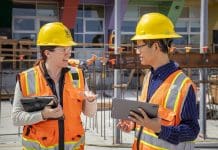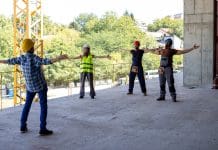Ben Cheeseman, commercial director at Harwood Building Control, sheds light on the significance of Approved Document M, highlights commonly overlooked areas, and discusses the implications of such oversights
Glenigan has recently reported the upturn in office refurbishment work, with organisations looking to reconfigure their workspaces to accommodate hybrid working.
With this type of refurbishment work, there are building control considerations that must be taken into account, particularly around Approved Document M and accessibility.
During the process of refurbishing an office, it’s crucial to consider various building control factors. However, one aspect that tends to receive insufficient attention is Part M, which focuses on ensuring that buildings and their facilities are accessible and usable for all individuals.
Understanding approved document M
Approved Document M provides essential information regarding the ease of access to buildings and the utilisation of their facilities, including provisions for disabled visitors or occupants and the facilitation of movement within a building.
For new residential properties, volume 1 of Approved Document M contains three levels of guidance. However, when it comes to commercial properties like offices, Volume II should be referred to, as it covers non-residential buildings.
It’s worth noting that certain buildings, such as student accommodations, may resemble domestic premises but still require consideration for users other than residents. The configuration of the building determines the approach to be followed.
In some cases, commercial properties like holiday lets may benefit more from the guidance in volume 1.
While Part M addresses the requirements of building regulations, it’s important for designers and contractors to also consider the building’s users within the provisions of the Equality Act.
This ensures that the building and its facilities can be used by all individuals without discrimination.
Key considerations within Part M during an office refurbishment
In the context of commercial buildings like offices, Part M focuses on accessibility and access to services.
When extending an existing building, the regulations apply to the extension itself and any access points required to reach the new extension. However, other areas of the existing building are not covered by these regulations.
If you’re solely refurbishing the building, the requirement is to maintain or improve accessibility. For instance, if you’re refurbishing a two-storey building without a lift and you’re not altering its footprint, there’s no obligation to install a new lift. Nonetheless, it is always recommended if feasible.
Traditionally, if an existing building cannot be modified to provide physical access, an Access Statement is usually provided. This statement may suggest alternative arrangements for services or facilities.
For example, if a wheelchair user accepts a job in a two-storey building without a lift, all the necessary equipment could be relocated to a ground floor location to ensure accessibility.
It is important to consult with access auditors when regarding a building’s accessibility
When refurbishing offices, the typical accessibility considerations for wheelchair users often include reception areas with lowered desks and additional knee space, accessible toilets, and kitchen areas with lowered or adjustable worktops, as well as appropriate parking.
However, it’s important to note that decision-makers regarding the building’s accessibility might not always consider solutions based on firsthand experience.
We advise clients to consult with local access groups or qualified Access Auditors during the building process to ensure the adoption of a best practice approach. Neglecting this approach may result in overlooking certain areas by mistake.
Which areas tend to be overlooked when providing fire-safe accessibility routes?
One area that requires greater consideration is how wheelchair users can safely exit a building in the event of a fire. When lifts are unavailable, the standard practice is for wheelchair users to wait in a safe area until assisted evacuation by the building management, often involving transfer to an evacuation chair.
This process is not the most efficient, so there should be a strategy in place to prevent fires from reaching certain areas of the building.
Considerations related to door and corridor width should also be taken into account. If entrance turnstiles or other access control security measures are in use, a bypass facility should be provided for wheelchair users and individuals with guide dogs. This ensures rapid and unobstructed egress.
In areas where individuals may need to wait outside before gaining access, such as those utilising an intercom system, there should be a recessed entrance or a canopy to shield people from adverse weather conditions while waiting.
For individuals with sight loss, other considerations can sometimes be overlooked, including the importance of colour contrast. Door handles should contrast with doors, doors should contrast with frames, and frames should contrast with the colour of the wall.
These simple adjustments allow people with impaired vision to easily identify the location of doors.
Part M doesn’t provide extensive details on accessibility for individuals with hearing loss, apart from the consideration of induction loops in reception areas and meeting rooms.
However, this has a direct impact on fire safety. If there are areas in the building where an individual with hearing loss might be alone, measures must be taken to ensure they can be informed about a fire.
Installing a flashing beacon is one possible solution. While it is often assumed that beacons are only necessary in accessible restrooms, greater consideration should be given to any space where an individual might be alone, which frequently extends beyond accessible toilets.
During construction, the choice of materials, especially for door handles, should also be considered. Door handles should not be made of materials that feel excessively cold to the touch, as some individuals may have a negative reaction to extremely cold objects.
Popular materials like chrome, steel, and polished metal, while aesthetically pleasing, can pose challenges when it comes to temperature sensitivity.
What are the implications of overlooking these considerations?
It’s important to recognise that there is significant overlap between Part M in building regulations and the responsibilities of occupiers and employers under the Equality Act.
In theory, if buildings fail to comply with regulations, penalties stipulated by the building regulations can be imposed. However, it’s not mandatory to follow the guidance in the
Approved Documents and this guidance might not meet the needs of all potential building users. Unfortunately, apart from fire safety-related means of escape, accessibility is seldom a matter of life or death.
As a result, Part M may not be as well understood or treated as seriously as other areas of the building regulations. Building owners and occupants are more likely to face claims of discrimination under the Equality Act.
From a building developer’s perspective, adhering strictly to the guidance in Part M offers a certain degree of protection under the Equality Act.
For instance, the majority of developers closely follow the guidelines for accessible toilets, to the extent that it is now referred to as a ‘Doc M Pack’ in the industry.
When collaborating with clients seeking to refurbish commercial buildings, Harwood aims for full compliance with building regulations, including Part M.
Ben Cheeseman
Commercial director
Harwood Building Control














